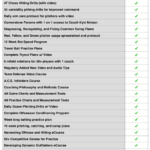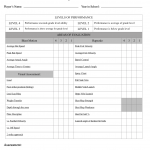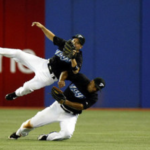Developing an Athlete Centered Coaching Style Part III: Troubleshooting
When I began coaching the answer to any issue we were having on the team had two components, yelling and running. This was a very effective short term motivator and many times the behavior was corrected almost immediately. At the time, this was the only means I knew and I thought it was very effective because I was seeing results. What I noticed was, while I was changing the short term behavior, we were having the same issues every year. We were not making any long term change in our programs behavior. That is when I knew I needed a new approach. The teams were becoming "my" teams, not the athlete's team. I needed to make a change and take the team from my team to our team, then to the kid’s team.
My teams were performing well on the field, but I doubt I taught them anything other than how to play baseball and how to take orders. My coaching probably did very little to develop leaders or improve their lives off the field.
Sign Up For Free Access To Our Bronze Coaching Library
Transitioning to an athlete centered team will not happen overnight. In fact, if you try to make the transition extremely quickly, it will probably fail. The players my first few years were so used to me running everything and telling them exactly how to behave in every situation that they would have fallen flat on their face had I suddenly turned it over to them. A large transition needs to happen slowly (usually a couple of years). Smaller changes can happen almost immediately. Simply begin allowing players to take responsibility for anything they can handle. No matter how small the task, players will benefit from taking ownership of small tasks.
The most difficult question for me to answer as I was making this transition was “how do I discipline my athletes without yelling and conditioning?”
Below is a quick list of actions that can be taken to discipline athletes without conditioning
1.) Develop a culture of respect- If the athlete doesn't feel as though you respect them, they will not respect you. In today's society the position of "coach" does not automatically earn you respect. Unfortunately, some parents create an environment at home where the coach is the enemy. Respecting athletes as more than just players and showing that you care about their well being in all aspects of their life can help overcome this.
2.) Communicate- If there is a problem, simply talking to athlete, listening to their side and expressing your concern over a behavior goes a long way. If the athlete knows you have their best interest in mind, a simple conversation will take care of 90% or more of the problems on a team and you will be surprised what you can learn by listening. I cannot tell you how many times there has been a problem, I talk to the athlete about it instead of flying off the handle and I learn some insight into their life that helps me manage them later on down the road. If it is a problem between two athletes, talk with them separately first, then bring them together to discuss the issue.
3.) Take a breather before making a decision. Many times discipline is dished out during an emotional time and this is when mistakes can easily be made. Do not let the problem sit too long, but make sure you are calm and collected and you have carefully thought through your actions prior to taking them.
4.) Take away a privilege. The obvious one in this realm is playing time in games, but I know coaches who take away practice time as well. We used to make kids run and do extra field work if they were late to practice, now we simply have kids sit out a portion or all of practice. Our tardies have decreased significantly (even at our before school practices in the early spring) since we switched away from conditioning as a punishment.
5.) Lean on your athletes. If there is a discipline matter that can be discussed with the entire team or with your captains, listen to them and get their take on the situation. We often think of peer pressure as a negative influence, but it can be surprisingly positive as well. If you create a feeling of family on your team, athletes will not want to let their fellow teammates down.
6.) Keep in mind the ultimate goal of discipline - The real goal of discipline should not be to punish for past offenses, it should be to discourage future offenses and to encourage living up to the standards that have been set. Yelling, screaming, and making players condition for mistakes or discipline issues may not accomplish this goal in the long term. Another negative side effect of making players condition for punishment is they begin to resent conditioning. Their view of conditioning becomes negative, and they begin to associate conditioning with punishment. I want my players to view conditioning as an opportunity for improvement.
There are many other ways you can deal with discipline other than the traditional yelling and conditioning. I challenge you to be creative. The traditional means of discipline are easy because we are familiar with them and they do change behavior in the short term. Instead of short term behavior change, try to change the culture in your program to where certain behaviors are unacceptable because they will let the team down, not because they face the threat of conditioning or verbal reprimand.
 Posted by Kyle Nelson
Posted by Kyle Nelson- Posted in Uncategorized
 Oct, 25, 2013
Oct, 25, 2013 2 Comments.
2 Comments.
Elite members login here
Check out what’s New/Hot!
Recognizing, Diagnosing, and Fixing Common Hitting Flaws eCourse The 3 metrics we tested on Blast motion sensors this year Sneak Peek Inside an Elite Q and A The batting practice continuum Elite Member’s area table of contents 50+ “Chaos” hitting drills
5 sample Chaos hitting drills FREE
Mental Skills and Culture Building The hitting pyramid Welcome Elite Member, Trey! Ideas for a pitcher first practice 12 week bat speed improvement plan Make plans this offseason to have your team playing their best baseball at the end of the year” Top 5 hitting drills to translate practice skill to game performanceHow we used Blast Motion sensors with a team in 2019
What to do if your hitters are overmatched Welcome Elite Member, Tommy! Setting your baserunners up for success Welcome Elite Member, Mike! A consulting call with Elite Member Matt FREE Web Clinic: Developing Athletic, Consistent, Extraordinary Infielders
 Coach Kyle Nelson
Coach Kyle Nelson





I agree with many points in the above article. We know even in the big time Division 1 Programs there are a group of players “Players Counsel” that meet with the Head Coach to address all issues and use it as a catalyst to address the entire team. I personally lean on my Captains to serve that role. Also, in listening to Coach K, I really took to heart that each & every player and situation deserves its own time & consequence.
I have a blanket rule that I learned from a great coach, good friend and Mentor; Bret Fleming of Laguna Beach HS. The rule is … Do not do anything that will bring negative attention to yourself, your school, your family or the Program. That simple “rule” allows me the freedom to effectively & individually Lead by addressing each & every situation for what I believe will direct the team and athlete(a) in a positive manner.
Thanks for your feedback Rob, I like that blanket rule!